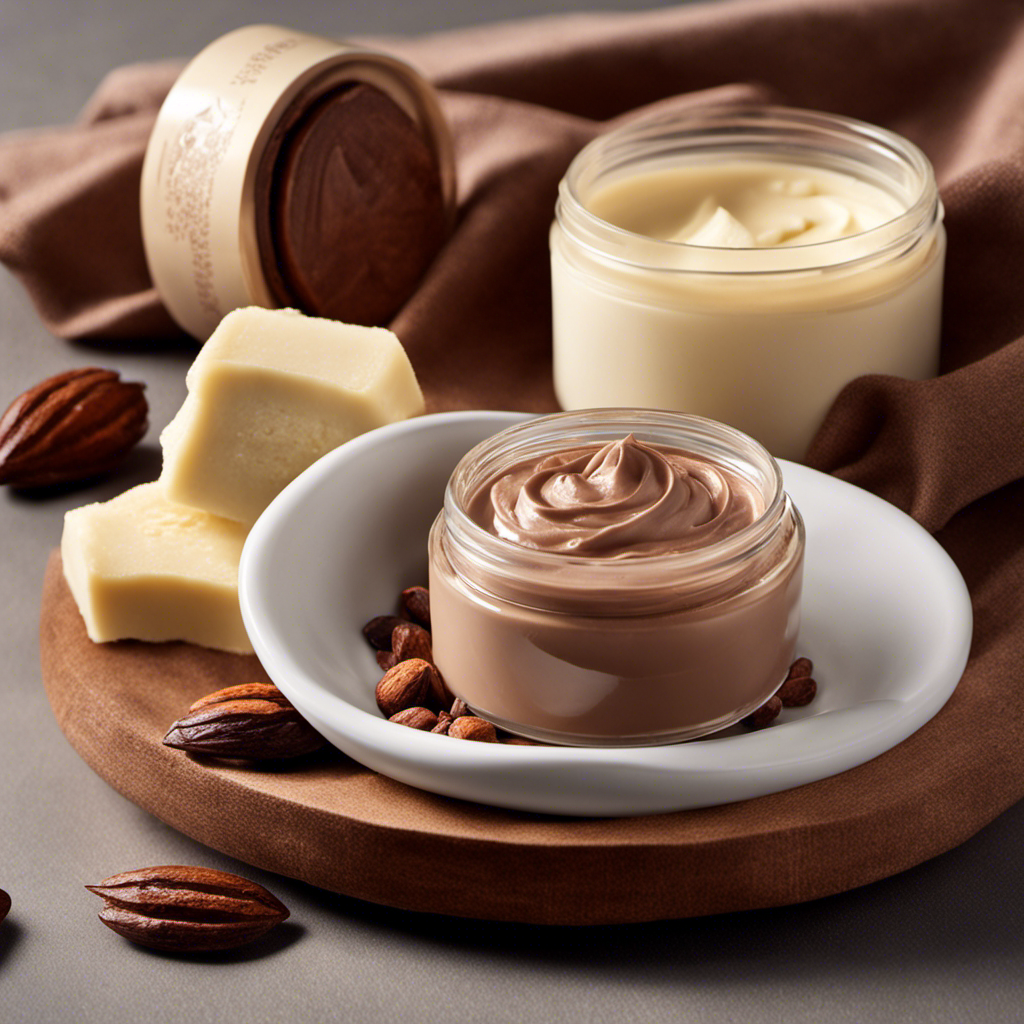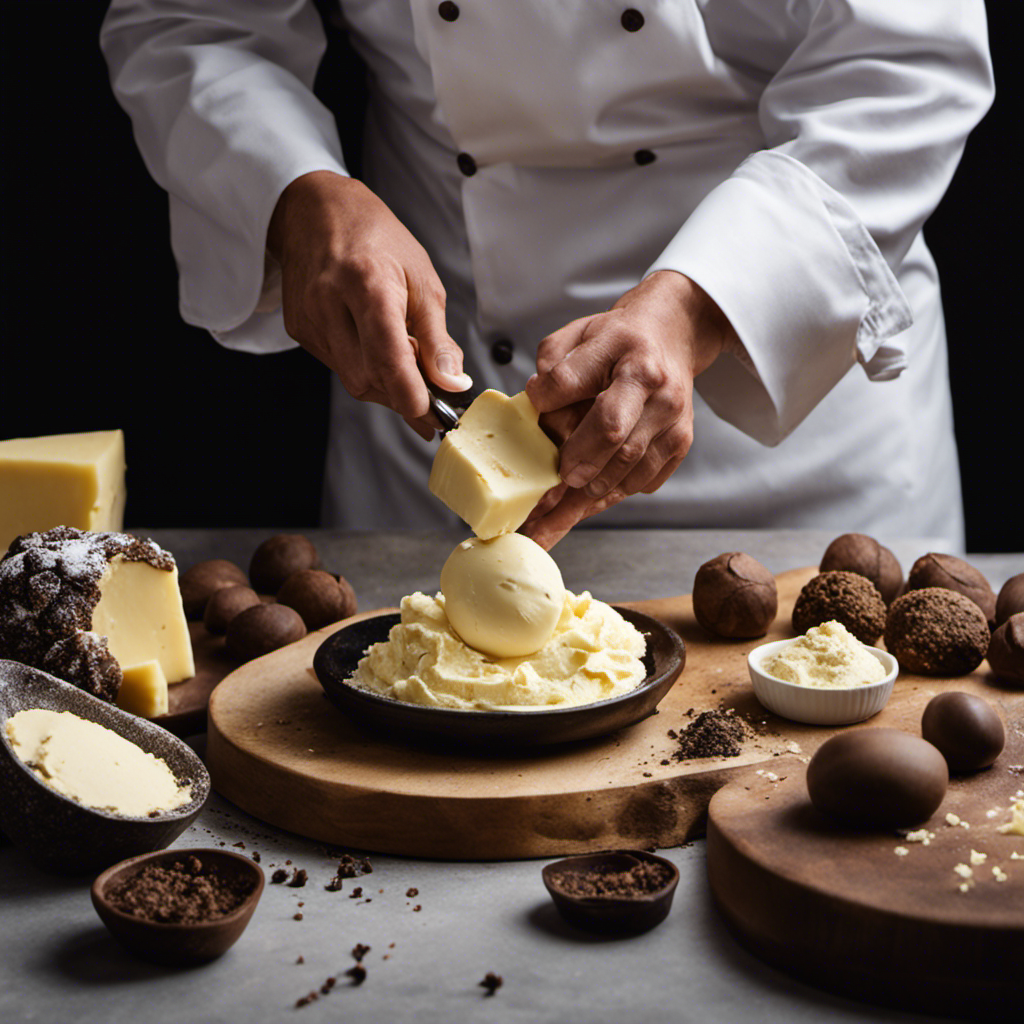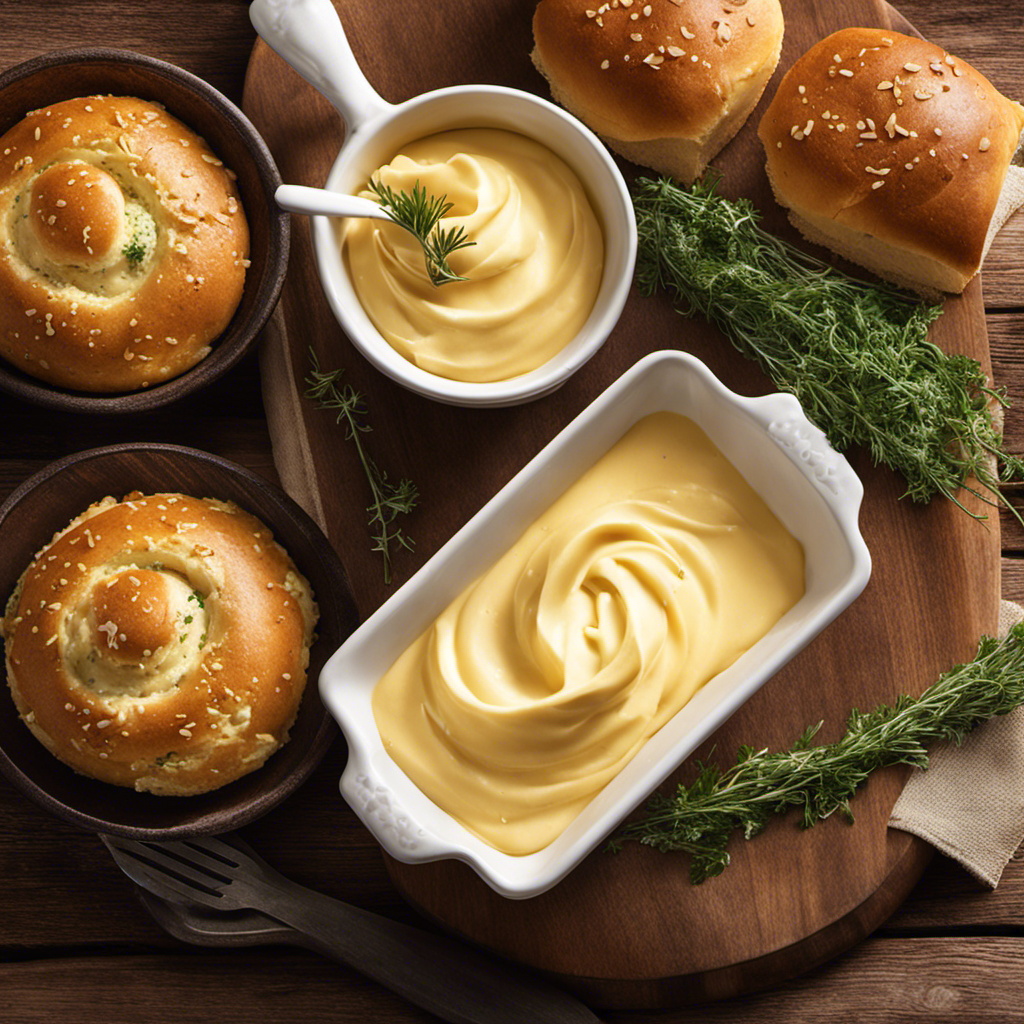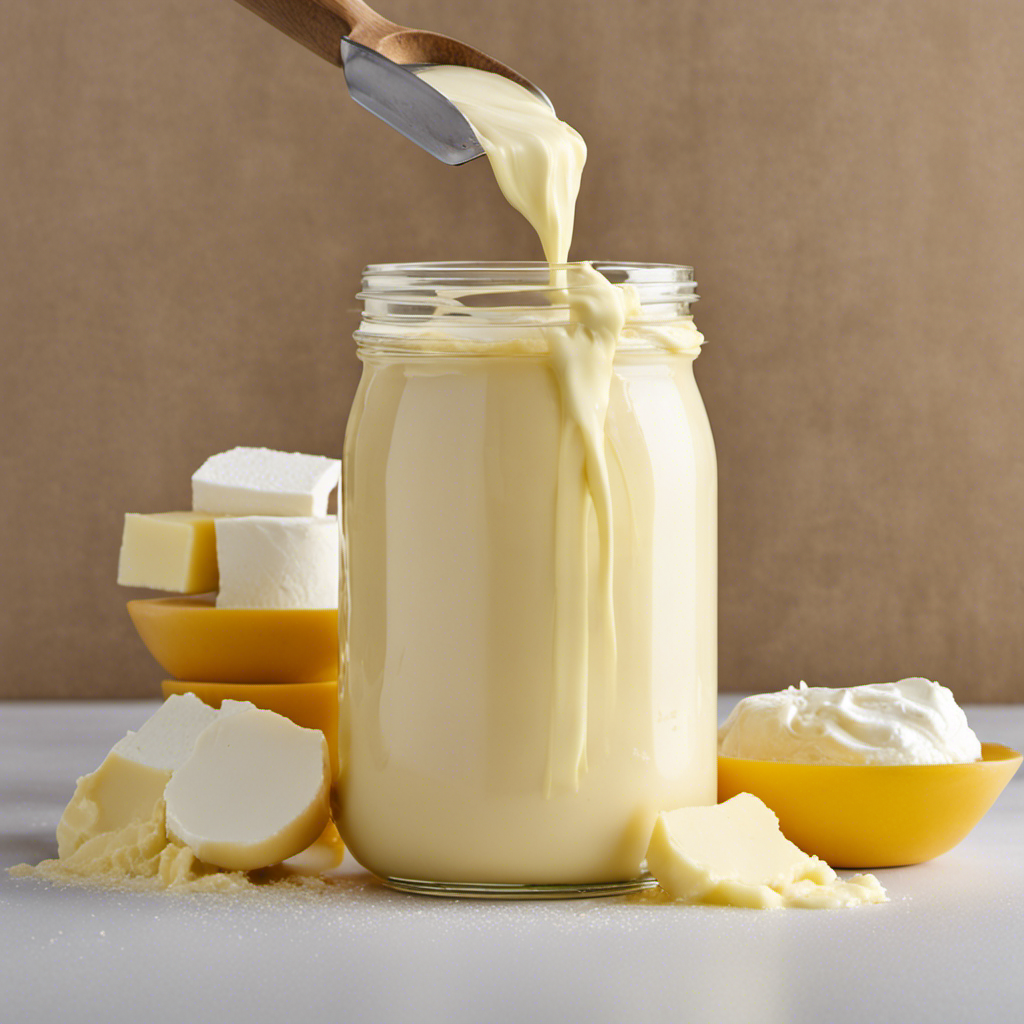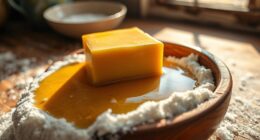I have always had challenges with dry skin, particularly in the winter months. However, I found the amazing benefits of cocoa butter.
This rich and creamy ingredient has become a staple in my skincare routine, helping me achieve smooth and moisturized skin.
In this article, I’ll share with you the benefits of cocoa butter and how to properly incorporate it into your skincare routine.
Get ready to say goodbye to dryness and hello to glowing, nourished skin.
Key Takeaways
- Cocoa butter moisturizes and nourishes the skin, leaving it soft and smooth.
- It contains antioxidants that protect the skin from damage caused by free radicals.
- Cocoa butter has well-documented effectiveness in reducing the appearance of scars and stretch marks.
- It soothes dry and irritated skin conditions and restores the skin’s moisture barrier.
Benefits of Cocoa Butter
You’ll love the benefits of cocoa butter for your skin. It helps to moisturize and nourish, leaving it feeling soft and smooth.
When choosing the right cocoa butter product, it’s important to look for one that is 100% pure and unrefined. This ensures that it retains all its natural goodness and effectiveness.
Cocoa butter is rich in antioxidants, which can help protect your skin from damage caused by free radicals. It also contains fatty acids that deeply hydrate and improve the elasticity of your skin.
The effectiveness of cocoa butter in reducing the appearance of scars and stretch marks has been well-documented. Additionally, it has soothing properties that can help alleviate dry and irritated skin conditions.
Incorporating cocoa butter into your skincare routine is a great way to achieve a healthy and radiant complexion.
Choosing the Right Cocoa Butter Product
When selecting the appropriate product, it’s important to consider the ingredients and its intended use. Cocoa butter and shea butter are both popular choices for skincare, but they have some key differences. Here are some factors to consider when choosing between them:
- Cocoa butter has a rich, chocolatey scent that can evoke feelings of comfort and indulgence.
- Shea butter has a nutty aroma that can make you feel grounded and connected to nature.
Different types of cocoa butter products include solid bars, lotions, creams, and lip balms.
Understanding these factors can help you make an informed decision about which product suits your needs and preferences.
Now that you know how to choose the right cocoa butter product, let’s move on to preparing your skin for its application.
Preparing Your Skin for Cocoa Butter
When it comes to preparing your skin for cocoa butter, there are a few key points to keep in mind.
First, exfoliating your skin before applying cocoa butter can help improve absorption and ensure that the product penetrates deeply.
Additionally, it’s important to hydrate your skin before application, as this can create a smooth and supple surface for the cocoa butter to be applied on.
Lastly, removing dead skin cells is crucial to allow the cocoa butter to effectively moisturize and nourish your skin.
Exfoliating for Better Absorption
To achieve better absorption, it’s important to exfoliate your skin before applying cocoa butter. Exfoliating removes dead skin cells and unclogs pores, allowing the cocoa butter to penetrate deeper into the skin.
Here are some effective exfoliating techniques to consider:
- Physical exfoliation: Using a scrub or brush to physically remove dead skin cells.
- Chemical exfoliation: Using products like alpha hydroxy acids (AHAs) or beta hydroxy acids (BHAs) to dissolve dead skin cells.
- Exfoliating tools: Such as exfoliating gloves or loofahs to gently slough off dead skin.
Regular exfoliation offers numerous benefits for your skin, including:
- Smoother texture and brighter complexion.
- Improved absorption of skincare products.
- Reduction in the appearance of fine lines and wrinkles.
By exfoliating before applying cocoa butter, you can maximize its effectiveness and enjoy its nourishing benefits.
Now, let’s move on to the next step: hydrating before application.
Hydrating Before Application
Make sure you hydrate your skin before applying anything else. Hydrating your skin is essential for achieving optimal results when using cocoa butter or any other moisturizer. When your skin is properly hydrated, it becomes more receptive to the moisturizing benefits of cocoa butter, allowing it to penetrate deeper and nourish your skin from within.
To effectively hydrate your skin, start by cleansing your face with a gentle cleanser to remove any dirt or impurities. Then, pat your skin dry with a clean towel.
Next, apply a hydrating toner or facial mist to replenish moisture and balance the pH of your skin. Follow this with a lightweight, hydrating serum or essence to provide an extra boost of hydration. Finally, seal in all the moisture with a moisturizer or facial oil.
Removing Dead Skin Cells
Exfoliating regularly is essential for removing dead skin cells and revealing a smoother complexion. Dead skin cells can accumulate on the surface of the skin, leading to a dull and uneven appearance. By exfoliating, you can effectively slough off these dead cells and promote the growth of new, healthier skin cells.
Here are some exfoliating techniques that can help you achieve a more radiant complexion:
- Physical exfoliation: Using a gentle scrub or brush to manually remove dead skin cells.
- Chemical exfoliation: Applying products with ingredients like alpha hydroxy acids (AHAs) or beta hydroxy acids (BHAs) to dissolve dead skin cells.
- Exfoliating masks: Using masks formulated with ingredients like clay or enzymes to gently exfoliate the skin.
By incorporating these exfoliating techniques into your skincare routine, you can achieve a smoother and more revitalized complexion.
Now, let’s move on to the next step – applying cocoa butter to dry skin.
Applying Cocoa Butter to Dry Skin
When your skin is dry, you can apply cocoa butter to moisturize and nourish it. Cocoa butter is a natural ingredient that is rich in antioxidants and fatty acids, making it an excellent choice for preventing dry skin. It helps to restore the skin’s moisture barrier, keeping it hydrated and supple. Additionally, cocoa butter has been found to have numerous benefits for eczema, a common skin condition characterized by dry, itchy, and inflamed skin. Its emollient properties help to soothe and relieve the symptoms of eczema, promoting healing and reducing inflammation. By incorporating cocoa butter into your skincare routine, you can effectively prevent dry skin and experience the many benefits it offers for eczema.
| Benefits of Cocoa Butter for Eczema | |
|---|---|
| Soothes Itching and Irritation | |
| Reduces Inflammation | |
| Promotes Healing |
Using Cocoa Butter for Stretch Marks
In my experience, cocoa butter has been an effective remedy for reducing the appearance of stretch marks.
Not only does it help to moisturize and nourish the skin, but it also promotes elasticity and collagen production.
When applying cocoa butter to stretch marks, I recommend using gentle circular motions to massage the product into the skin, focusing on the affected areas for maximum absorption and results.
Effectiveness of Cocoa Butter
The effectiveness of cocoa butter can vary depending on individual skin types and conditions. However, it is widely known for its moisturizing properties and has been used for centuries to nourish and hydrate the skin. Here are three reasons why cocoa butter is effective:
-
Deep hydration: Cocoa butter contains natural emollients that penetrate deep into the skin, providing long-lasting moisture and preventing dryness.
-
Skin elasticity: Regular use of cocoa butter can improve skin elasticity, making it more supple and reducing the appearance of fine lines and wrinkles.
-
Healing properties: Cocoa butter is rich in antioxidants and vitamins, which help to repair damaged skin cells and promote a healthy complexion.
Overall, cocoa butter is an effective moisturizer that can benefit a wide range of skin types, leaving your skin feeling smooth, hydrated, and rejuvenated.
Application Techniques for Stretch Marks?
Applying cocoa butter regularly can help improve the appearance of stretch marks by nourishing the skin and promoting elasticity. Stretch marks are a common concern for many individuals, especially during periods of rapid growth or weight gain. While there is no surefire way to prevent stretch marks entirely, using natural remedies such as cocoa butter can help minimize their appearance.
Cocoa butter is rich in antioxidants and fatty acids, which help to moisturize and nourish the skin. By keeping the skin hydrated and supple, cocoa butter can improve the elasticity of the skin, making it less prone to developing stretch marks.
To effectively use cocoa butter for stretch mark prevention, it is recommended to apply it generously to the affected areas twice daily, massaging it into the skin in circular motions.
Cocoa Butter for Chapped Lips
To soothe your chapped lips, you can apply cocoa butter for instant relief. Cocoa butter is a natural moisturizer that helps nourish and hydrate the skin.
Here are three reasons why cocoa butter is beneficial for chapped lips:
-
Deep Hydration: Cocoa butter has excellent emollient properties, which means it helps lock in moisture and prevent dryness. It forms a protective barrier on the lips, keeping them soft and supple.
-
Healing Properties: Cocoa butter contains antioxidants that promote skin cell regeneration. Applying cocoa butter to chapped lips helps speed up the healing process, reducing pain and discomfort.
-
Natural Protection: Cocoa butter acts as a shield against harsh environmental factors, such as cold weather and wind. It helps prevent further damage to the delicate skin on your lips.
In addition to chapped lips, cocoa butter can also be beneficial for other dry areas of the body, such as cracked heels and dry cuticles. Its moisturizing properties help soften and nourish these areas, promoting overall skin health.
Incorporating Cocoa Butter Into Your Skincare Routine
When incorporating cocoa butter into your skincare routine, it’s important to be consistent and apply it regularly for best results.
Cocoa butter is a natural ingredient known for its moisturizing properties, making it ideal for dry skin. By incorporating cocoa butter into your daily routine, you can reap the benefits of its hydrating and nourishing effects.
This rich butter helps to lock in moisture and create a protective barrier on the skin, preventing dryness and promoting a smoother, more supple complexion. Not only does cocoa butter provide intense hydration, but it also contains antioxidants that can help to combat free radicals and promote healthier-looking skin.
So, if you’re looking for a natural solution to dry skin, incorporating cocoa butter into your daily routine is a must.
Now, let’s move on to some tips for storing cocoa butter properly…
Tips for Storing Cocoa Butter Properly
Now that you know how to incorporate cocoa butter into your skincare routine, it’s important to understand the proper way to store it. Proper storage is crucial in preventing cocoa butter from melting and losing its beneficial properties.
Here are some tips to ensure your cocoa butter stays in top condition:
-
Keep it in a cool, dry place: Store your cocoa butter in a location away from direct sunlight and heat sources. Excessive heat can cause it to melt and lose its texture.
-
Use airtight containers: Transfer your cocoa butter into airtight containers to prevent moisture and air from getting in. This will help maintain its quality and prevent rancidity.
-
Avoid frequent temperature changes: Rapid changes in temperature can cause condensation, which can affect the texture and quality of your cocoa butter.
Frequently Asked Questions
Can Cocoa Butter Be Used on Sensitive Skin?
Yes, cocoa butter can be used on sensitive skin. It has numerous benefits, including its ability to soothe and moisturize. Cocoa butter is often recommended for conditions like eczema due to its nourishing properties.
What Is the Recommended Frequency of Applying Cocoa Butter to Dry Skin?
The recommended frequency for applying cocoa butter to dry skin depends on individual needs, but generally, using it daily or as needed can provide the benefits of moisturizing, nourishing, and rejuvenating the skin.
Are There Any Potential Side Effects or Allergies Associated With Cocoa Butter?
I’ll admit, cocoa butter sounds like a miracle for dry skin. But let’s address the elephant in the room – potential side effects and allergies. It’s important to be cautious and aware of any potential skin reactions when using cocoa butter.
Can Cocoa Butter Be Used on All Types of Stretch Marks?
Yes, cocoa butter can be used on all types of stretch marks. It is effective for both old and new stretch marks. Additionally, cocoa butter is also beneficial for reducing the appearance of acne scars.
How Long Does It Typically Take to See Results When Using Cocoa Butter for Chapped Lips?
It usually takes a few days to see results when using cocoa butter for chapped lips. I’ve found it to be effective in moisturizing and healing dry hands as well as providing benefits for my hair.
Conclusion
In conclusion, cocoa butter is a versatile and beneficial ingredient to incorporate into your skincare routine. It can help moisturize and nourish the skin, reduce the appearance of stretch marks, and soothe chapped lips.
One interesting statistic is that cocoa butter is rich in antioxidants, which can help fight free radicals and protect the skin from environmental damage.
So, why not give cocoa butter a try and enjoy its many benefits for your skin?
